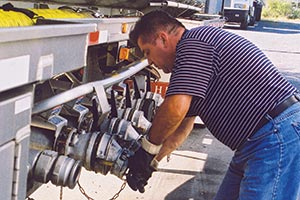Senior Reporter
Regulators Forced to Drop Plan to Retrofit Tank Truck Wetlines

Federal regulators will soon be required to abandon plans to issue a final rule requiring tank truck carriers that haul flammable liquids to either retrofit their existing trailers to protect their wetlines or install a system to purge product from those lines.
Although the U.S. Pipeline and Hazardous Materials Safety Administration has said for nearly two months that it plans to withdraw the rule it proposed in January 2011, the agency will now have no choice but to do so. The new transportation act mandates the proposed rule be dropped within a month after the legislation was signed Dec. 4.
Further, the law marks the end of a decadelong trucking industry fight with PHMSA, as carriers have maintained that the proposal was too costly and unnecessary.
“We’re pleased. We wish we didn’t have to take so long and fight this many times and invest as much as we have,” said Daniel Furth, president of National Tank Truck Carriers. “There’s just no factual basis to implement such a rule that would make the industry retrofit about 30,000 trailers across the country.”
“There hasn’t been any catastrophic accident that has been directly attributed to wetlines,” Furth told Transport Topics. “You might have some accidents where a drunk driver goes through a stop sign and hits the middle of a truck, but the reality is that trucks don’t go sideways.”
Henry Jasny, general counsel for the Advocates for Highway and Auto Safety, said it was “unfortunate” that Congress is forcing the agency to withdraw the proposed rule.
“It’s not a major safety issue, but it was something that could have avoided a number of serious problems,” Jasny said in an interview last week. “It was viewed as burdensome, and the industry that deals with wetlines didn’t want the burden.”
PHMSA, a division of the U.S. Department of Transportation, did not return a message requesting comment on the congressional mandate by press time.
The agency and the National Transportation Safety Board have been pushing for a wetlines rule for many years because of their concerns that exposed wetlines could cause a serious fire if they are ruptured in a crash.
Wetlines are pipes and valves under the cargo tank that are used for bottom loading of gasoline or other petroleum products. A 9,000-gallon tank trailer may contain five separate compartments, allowing more than one product to be transported, according to PHMSA. Each compartment has its own wetline. The hardware is designed to break off if struck by an object or another vehicle, preventing larger spills, the agency said.
The original justification for the wetlines rule dates back to 1998, when NTSB first recommended prohibiting carrying hazardous materials in wetlines after a fatal wetlines accident in Yonkers, New York, the year before.
In that accident on Oct. 9, 1997, a passenger sedan hit the area of the gasoline lines. Both vehicles were engulfed in fire that killed the driver of the sedan but did not injure the truck driver. The driver of the car was blamed for the accident because he failed to stop at a red light or reduce his speed. The NTSB investigation concluded the crash fractured one or more of the cargo tank’s loading lines, releasing up to 28 gallons of gasoline. Had the lines been empty, the fire would likely not have occurred, NTSB said, and it subsequently issued in 1998 a recommendation that equipment be installed to empty the lines after fuel deliveries.
However, there was opposition to PHMSA’s initial wetlines proposal in 2006, so the agency withdrew it.
In 2009, the agency reviewed 6,800 commercial vehicle accidents that occurred as far back as 1999 and documented 172 in which wetlines were either damaged or ruptured. Of that total, 18 of those incidents involved fires resulting in five fatalities, four injuries and millions of dollars in property damage, PHMSA said.
But a 2013 Government Accountability Office study blasted the agency for using faulty crash data to support the 2011 proposal.
“PHMSA’s analysis overstated the number of fatalities the proposed rule would prevent when considering actual past incidents,” GAO said, adding that the agency did not consider uncertainties in the analysis for its 2011 wetlines proposal, an action that is required under federal law.
The 2011 rule, if finalized, would have given tank truck operators 12 years after publication of a final rule to make the changes on existing tanks that carry flammable liquids. Any trailer manufactured two years after the effective date of the regulation would have to be equipped with redesigned lines: accident-damage protection sim¬ilar to a rear bumper or a system that would purge wetlines of all but one liter of product in each line, the rule said.

